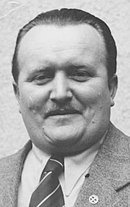Anton Vašek
Anton Vašek (1905–1946)[1] was the head of Department 14 in the Slovak State's Central Economic Office. He is known for accepting bribes in exchange for reducing deportation of Jews from Slovakia.

Life
Vašek attended law school. One of his classmates was the Jewish Tibor Kováč.[2][3]
On 3 April 1942, Vašek was appointed head of Department 14 in the Slovak State's Central Economic Office. This department was in charge of organizing the deportations during the Holocaust in Slovakia.[4] Vašek was soon approached by Kováč, who was now a member of the Working Group, a Jewish resistance organization. Due to their prior relationship, Kováč was able to bribe Vašek, and visited his office almost daily to deliver bribes and provide Vašek with excuses to explain delays in deportations to his superiors.[3] Vašek's desire for money to fund his gambling and womanizing made him susceptible to bribery;[5][6] he was the highest-ranking Slovak official to accept bribes from the Working Group.[7][5] Due to Vašek's intervention, a 26 June transport of Jews was cancelled; Vašek presented Interior Minister Alexander Mach with a falsified report that all non-exempt Jews had already been deported. Mach was skeptical about the report, however, and the deportations resumed in July.[8]
Although Vašek accepted thousands of Slovak koruna in bribes,[9] he continued to organize transports[10][6] and said that the "Jewish question must be solved 100 percent".[11] Due to his high-handedness in exercising power over life and death, Vašek became known as the "king of the Jews" (Slovak: Židovský kráľ).[5][6][12] He was known to pull Jews out of cattle cars after receiving a bribe, only to send them on the next transport.[6]
Vašek was tried by the National Tribunal, accused of accepting 2 million koruna in bribes[13] and being responsible for the deportation of 50,000 Slovak Jews to concentration camps.[14] Kovăc was a key witness for the prosecution at the trial.[15][16] He was convicted on 28 July 1946,[14] sentenced to death, and executed.[12]
References
- Kerenji 2014, p. 276.
- Paldiel 2017, p. 131.
- Fatran 1994, pp. 168–169.
- Bauer 1994, p. 66.
- Fatran 1994, p. 168.
- Kamenec 2011b, p. 107.
- Friling 2005, p. 213.
- Fatran 1994, p. 170.
- Rajcan, Vadkerty & Hlavinka 2018, p. 847.
- Fatran 2002, p. 151.
- Kamenec 2002, p. 129.
- Edelheit 2018, p. 457.
- Lettrich 1955, p. 185.
- "Slovak Nazi Responsible for Death of 50,000 Jews Sentenced to Death in Bratislava". Jewish Telegraphic Agency. 28 July 1946. Retrieved 12 December 2019.
- Fatran 1994, p. 200.
- Matthäus 2013, p. 234.
- Sources
- Bauer, Yehuda (1994). Jews for Sale?: Nazi-Jewish Negotiations, 1933–1945. New Haven: Yale University Press. ISBN 978-0-300-05913-7.CS1 maint: ref=harv (link)
- Edelheit, Abraham (2018). History Of The Holocaust: A Handbook And Dictionary. Routledge. ISBN 978-0-429-97336-9.CS1 maint: ref=harv (link)
- Fatran, Gila (1994). Translated by Greenwood, Naftali. "The "Working Group"". Holocaust and Genocide Studies. 8 (2): 164–201. doi:10.1093/hgs/8.2.164. ISSN 8756-6583.CS1 maint: ref=harv (link)
- Fatran, Gila (2002) [1992]. "The Struggle for Jewish Survival during the Holocaust". In Długoborski, Wacław; Tóth, Dezider; Teresa, Świebocka; Mensfelt, Jarek (eds.). The Tragedy of the Jews of Slovakia 1938–1945: Slovakia and the "Final Solution of the Jewish Question". Translated by Mensfeld, Jarek. Oświęcim and Banská Bystrica: Auschwitz-Birkenau State Museum and Museum of the Slovak National Uprising. pp. 141–162. ISBN 978-83-88526-15-2.CS1 maint: ref=harv (link)
- Friling, Tuvia (2005). Arrows in the Dark: David Ben-Gurion, the Yishuv Leadership, and Rescue Attempts During the Holocaust. 1. Madison: University of Wisconsin Press. ISBN 978-0-299-17550-4.CS1 maint: ref=harv (link)
- Kamenec, Ivan (2002) [1992]. "The Deportation of Jewish Citizens from Slovakia in 1942". In Długoborski, Wacław; Tóth, Dezider; Teresa, Świebocka; Mensfelt, Jarek (eds.). The Tragedy of the Jews of Slovakia 1938–1945: Slovakia and the "Final Solution of the Jewish Question". Translated by Mensfeld, Jarek. Oświęcim and Banská Bystrica: Auschwitz-Birkenau State Museum and Museum of the Slovak National Uprising. pp. 111–139. ISBN 978-83-88526-15-2.CS1 maint: ref=harv (link)
- Kamenec, Ivan (2011). "Fenomén korupcie v procese tzv. riešenia "židovskej otázky" na Slovensku v rokoch 1938–1945" [The phenomenon of corruption in the so-called solutions to the "Jewish questions" in Slovakia between 1938 and 1945]. Forum Historiae (in Slovak). 5 (2): 96–112. ISSN 1337-6861. Archived from the original on 2018-10-06. Retrieved 2019-12-12.
- Kerenji, Emil (2014). Jewish Responses to Persecution: 1942–1943. Rowman & Littlefield. ISBN 978-1-4422-3627-1.CS1 maint: ref=harv (link)
- Lettrich, Jozef (1955). History of Modern Slovakia. Praeger.CS1 maint: ref=harv (link)
- Matthäus, Jürgen (2013). Jewish Responses to Persecution: 1941–1942. Lanham: AltaMira Press. ISBN 978-0-7591-2259-8.CS1 maint: ref=harv (link)
- Paldiel, Mordecai (2017). Saving One's Own: Jewish Rescuers During the Holocaust. Lincoln: University of Nebraska Press. ISBN 978-0-8276-1297-6.CS1 maint: ref=harv (link)
- Rajcan, Vanda; Vadkerty, Madeline; Hlavinka, Ján (2018). "Slovakia". In Megargee, Geoffrey P.; White, Joseph R.; Hecker, Mel (eds.). Camps and Ghettos under European Regimes Aligned with Nazi Germany. Encyclopedia of Camps and Ghettos. 3. Bloomington: United States Holocaust Memorial Museum. pp. 842–852. ISBN 978-0-253-02373-5.CS1 maint: ref=harv (link)